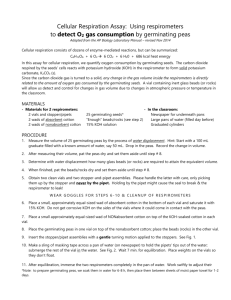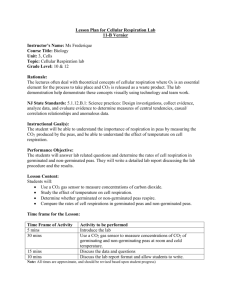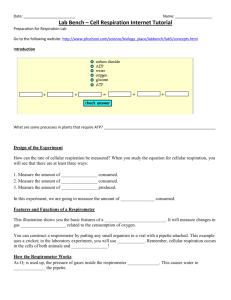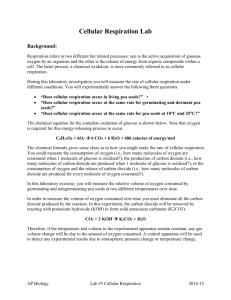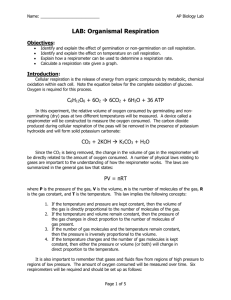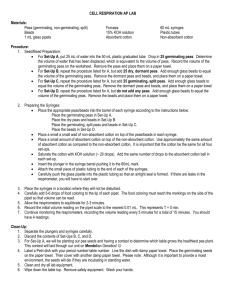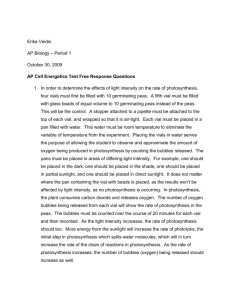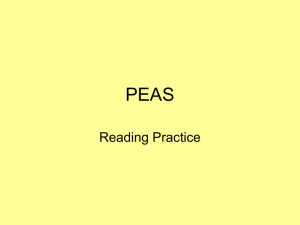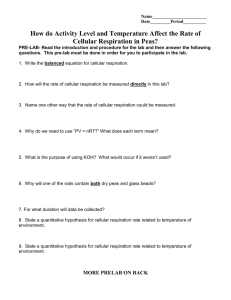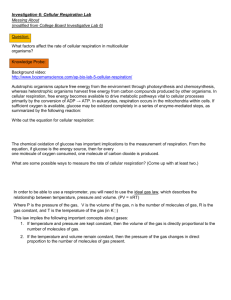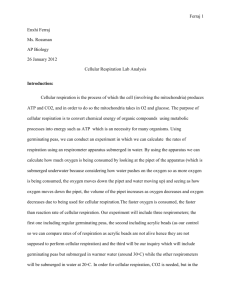cell respiration lab
advertisement
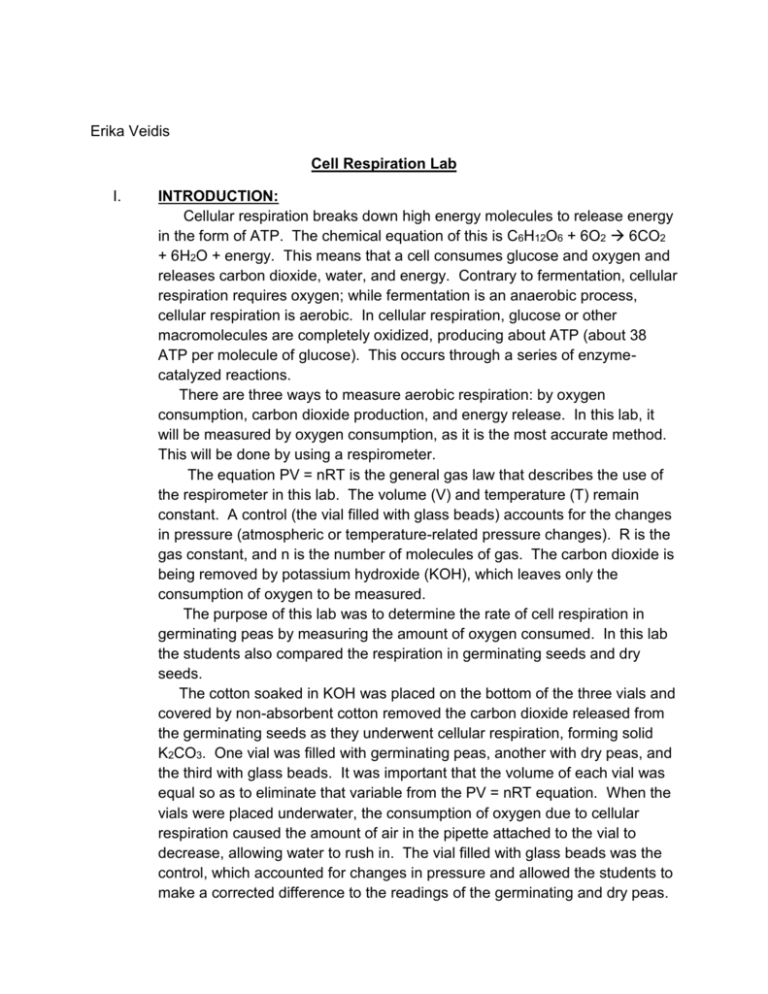
Erika Veidis Cell Respiration Lab I. INTRODUCTION: Cellular respiration breaks down high energy molecules to release energy in the form of ATP. The chemical equation of this is C6H12O6 + 6O2 6CO2 + 6H2O + energy. This means that a cell consumes glucose and oxygen and releases carbon dioxide, water, and energy. Contrary to fermentation, cellular respiration requires oxygen; while fermentation is an anaerobic process, cellular respiration is aerobic. In cellular respiration, glucose or other macromolecules are completely oxidized, producing about ATP (about 38 ATP per molecule of glucose). This occurs through a series of enzymecatalyzed reactions. There are three ways to measure aerobic respiration: by oxygen consumption, carbon dioxide production, and energy release. In this lab, it will be measured by oxygen consumption, as it is the most accurate method. This will be done by using a respirometer. The equation PV = nRT is the general gas law that describes the use of the respirometer in this lab. The volume (V) and temperature (T) remain constant. A control (the vial filled with glass beads) accounts for the changes in pressure (atmospheric or temperature-related pressure changes). R is the gas constant, and n is the number of molecules of gas. The carbon dioxide is being removed by potassium hydroxide (KOH), which leaves only the consumption of oxygen to be measured. The purpose of this lab was to determine the rate of cell respiration in germinating peas by measuring the amount of oxygen consumed. In this lab the students also compared the respiration in germinating seeds and dry seeds. The cotton soaked in KOH was placed on the bottom of the three vials and covered by non-absorbent cotton removed the carbon dioxide released from the germinating seeds as they underwent cellular respiration, forming solid K2CO3. One vial was filled with germinating peas, another with dry peas, and the third with glass beads. It was important that the volume of each vial was equal so as to eliminate that variable from the PV = nRT equation. When the vials were placed underwater, the consumption of oxygen due to cellular respiration caused the amount of air in the pipette attached to the vial to decrease, allowing water to rush in. The vial filled with glass beads was the control, which accounted for changes in pressure and allowed the students to make a corrected difference to the readings of the germinating and dry peas. II. III. The germinating seed should respire more than the dry seed. The germinating seed needs more oxygen as it is growing; it is dormant. The dry seed doesn’t need as much or any oxygen as it is not growing. Oxygen is necessary for cellular respiration, which would be especially important to a growing seed. Contrastingly, it is not necessary for a seed that is not germinating, like a dry seed. MATERIALS: Water 100 mL graduated cylinder 10 germinating peas 10 dried peas Glass beads 3 vials KOH (CO2 remover) Absorbent cotton Non-absorbent cotton Pipette attached to stopper Pyroform tape 3 weights Large pan Tape (to use as a sling for apparatuses) Food dye PROCEDURE: 1. The volume of 10 germinating seeds was found by pouring water in the graduated cylinder, recording the initial volume, and then recording the final volume after adding the seeds. 2. Another graduated cylinder was filled and the volume was recorded. 10 dry seeds were added, and then glass beads were added until the difference between the final volume and the initial volume (the volume of the added seeds/beads) equaled to the volume of the germinating seeds, found in #1. 3. The procedure was repeated for glass beads. 4. Absorbent cotton was placed on the bottom of each of three vials. 5. The cotton was moistened by dripping KOH on it. It was vital not to hit the sides of the vial – only the cotton – as that could have altered the results. 6. Non-absorbent cotton was placed on top of the KOH-soaked cotton. 7. The pre-measured amounts of germinating seeds, dry seeds/ glass beads, and just glass beads were added to each of three vials. 8. A pipette that was attached to a stopper was placed on top of each vial. Pyroform tape was used to seal each vial. IV. 9. A weight was placed on each apparatus. 10. A pan was filled with water (room temperature). 11. A white sheet of paper was placed on the bottom of the pan to make reading the results on the pipette easier. 12. The vial was submerged and allowed to equilibrate for 7 minutes by submerging the vial but resting the pipette on a sling made by stretching a piece of tape across the pan. 13. At the end of the 7 minutes, the vials were completely submerged. 14. Food dye was added into the pipette to make the water mark on the pipette easier to determine. 15. After the vials were allowed to equilibrate for 3 minutes completely underwater, the students began gathering the results. RESULTS: Pea volume: 4 mL Time Beads alone (min) Reading Difference at time x 0 .92 ------------5 .90 .02 10 .89 -.01 15 .89 0 20 .88 .01 Germinating peas Dry peas and beads Reading Diff. Corrected Reading Diff Co. difference Diff .92 .82 .75 .68 .60 ----.10 .07 .07 .08 ------------.08 .06 .07 .07 .92 .88 .88 .88 .87 ---.04 0 0 .01 ---.02 -.01 0 0 V. ANALYSIS: The 4 mL of the peas/ beads was kept constant in all three vials to eliminate volume as a variable from the PV = nRT equation. The oxygen consumed over a 20-minute period was much greater in the germinating peas than the dry peas. The germinating peas (with a total of .28 mL) consumed a total of .27 mL more of oxygen than the dry peas/ glass beads, which consumed .01 mL. In 5 minutes, the germinating peas consumed .08 mL of oxygen, while the dry peas consumed .02 mL. In 10 minutes, it was .14 and .01 respectively. The consumption by the dry peas decreased due to the corrected difference, which was calculated by subtracting the difference in readings in the control group from the difference of the peas. In 15 minutes, the germinating peas consumed .21 mL of oxygen, significantly higher than the unchanging .01 mL of the dry peas/ beads. The final reading after 20 minutes revealed that the germinating peas consumed .28 mL and the germinating peas still had only consumed .01 mL. The rate of oxygen consumption was .014 mL/minute in the germinating peas; it was .0005 mL/minute in the dry peas. A possible source of error in this experiment could’ve been the insertion of the stopper attached to the pipette into the vial. If this wasn’t made completely airtight, then the results would’ve been greatly altered. Oxygen could’ve seeped through these crevices instead of solely through the pipette, and water could’ve rushed into the vial. It would also be problematic if the KOH got on the sides of the tube instead of just on the cotton, as then the peas would’ve been exposed to it, and the solid K2CO3 would’ve formed inside the vial by the peas. This might’ve obstructed the flow of oxygen into the peas. If the water was colder than room temperature, the rate of the reaction would’ve decreased, as the lower kinetic energy would’ve slowed things down. VI. CONCLUSION: This experiment explored possible ways to determine the rate of cell respiration and focused on doing so by measuring the consumption of oxygen. The difference between the rates of oxygen consumption and cell respiration depending on the state of the pea (germinating or dry) was observed. The germinating peas consumed more oxygen and had a higher rate of oxygen consumption than the dry peas, as the dry peas were dormant and were not undergoing cell respiration. The rate of oxygen consumption directly relates to the rate of cellular respiration, as oxygen is consumed to perpetuate cell respiration. Since the germinating peas had a high rate of oxygen consumption, it meant that their rate of cell respiration was much higher than the dry peas/ glass beads. Theoretically, the dry peas should’ve had no oxygen consumption, as they weren’t undergoing cell respiration. The chemical equation of cell respiration is C6H12O6 + 6O2 6CO2 + 6H2O + energy. Since oxygen is consumed during cell respiration as a reactant in the reaction, it made sense to measure its consumption to determine the rate of cell respiration in an organism. Measuring oxygen consumption was much more accurate and efficient than it would have been to measure the release of carbon dioxide or energy, which are products in the reaction. Though it was not a factor in this experiment, a temperature change could’ve altered the rates of cell respiration in the peas. A higher temperature would’ve meant more kinetic energy, which would’ve sped up the rate of the reaction. A lower temperature would’ve decreased this rate because of the decrease in kinetic energy. Temperature is a measure of kinetic energy. Too high or too low of a temperature could’ve kept the reaction from occurring at all. Too low of a temperature would’ve caused movement to almost stop, and the reaction wouldn’t have enough energy to begin or proceed. Too high of a temperature could’ve caused the enzymes perpetuating cell respiration to denature, or unravel and stop functioning, so the reaction would not occur.
